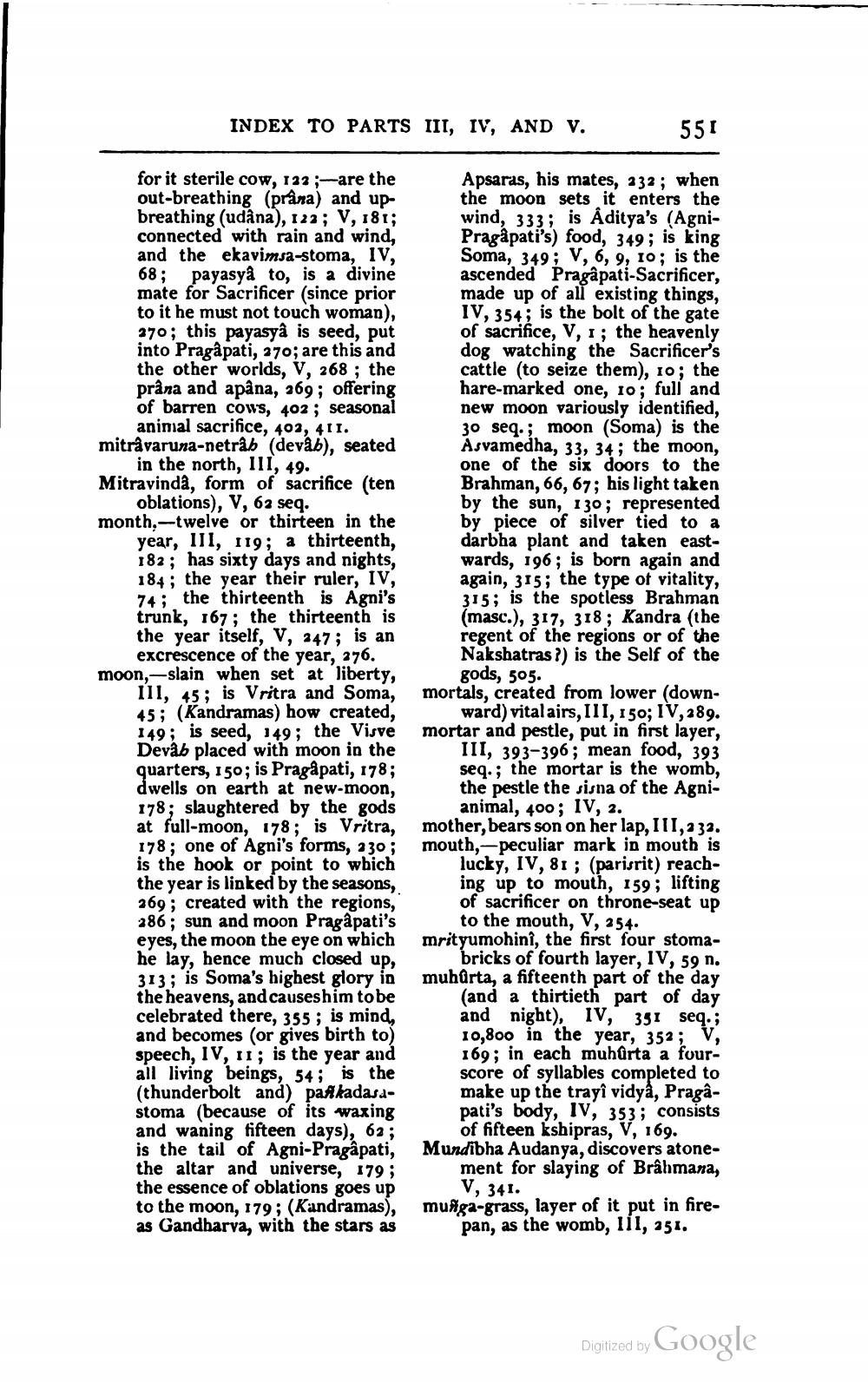________________
INDEX TO PARTS III, IV, AND V.
for it sterile cow, 122;-are the out-breathing (prana) and upbreathing (udâna), 122; V, 181; connected with rain and wind, and the ekavimsa-stoma, IV, 68; payasya to, is a divine mate for Sacrificer (since prior to it he must not touch woman), 270; this payasyâ is seed, put into Pragâpati, 270; are this and the other worlds, V, 268; the prâna and apâna, 269; offering of barren cows, 402; seasonal animal sacrifice, 402, 411. mitrâvaruna-netrâb (devâb), seated in the north, III, 49. Mitravindâ, form of sacrifice (ten
oblations), V, 62 seq. month,-twelve or thirteen in the year, III, 119; a thirteenth, 182; has sixty days and nights, 184; the year their ruler, IV, 74; the thirteenth is Agni's trunk, 167; the thirteenth is the year itself, V, 247; is an excrescence of the year, 276. moon, slain when set at liberty, III, 45; is Vritra and Soma, 45; (Kandramas) how created, 149; is seed, 149; the Visve Devâb placed with moon in the quarters, 150; is Pragâpati, 178; dwells on earth at new-moon, 178; slaughtered by the gods at full-moon, 178; is Vritra, 178; one of Agni's forms, 230; is the hook or point to which the year is linked by the seasons, 269; created with the regions, 286; sun and moon Pragâpati's eyes, the moon the eye on which he lay, hence much closed up, 313; is Soma's highest glory in the heavens, and causes him to be celebrated there, 355; is mind, and becomes (or gives birth to) speech, IV, 11; is the year and all living beings, 54; is the (thunderbolt and) paЯkadasastoma (because of its waxing and waning fifteen days), 62; is the tail of Agni-Pragâpati, the altar and universe, 179; the essence of oblations goes up to the moon, 179; (Kandramas), as Gandharva, with the stars as
551
Apsaras, his mates, 232; when the moon sets it enters the
wind, 333; is Aditya's (AgniPragapati's) food, 349; is king Soma, 349; V, 6, 9, 10; is the ascended Pragâpati-Sacrificer, made up of all existing things, IV, 354; is the bolt of the gate of sacrifice, V, 1; the heavenly dog watching the Sacrificer's cattle (to seize them), 10; the hare-marked one, 10; full and new moon variously identified, 30 seq.; moon (Soma) is the Asvamedha, 33, 34; the moon, one of the six doors to the Brahman, 66, 67; his light taken by the sun, 130; represented by piece of silver tied to a darbha plant and taken eastwards, 196; is born again and again, 315; the type of vitality, 315; is the spotless Brahman (masc.), 317, 318; Kandra (the regent of the regions or of the Nakshatras?) is the Self of the gods, 505.
mortals, created from lower (down
ward) vital airs, III, 150; IV, 289. mortar and pestle, put in first layer,
III, 393-396; mean food, 393 seq.; the mortar is the womb, the pestle the sisna of the Agnianimal, 400; IV, 2. mother, bears son on her lap, III, 232. mouth, peculiar mark in mouth is
lucky, IV, 81; (parisrit) reaching up to mouth, 159; lifting of sacrificer on throne-seat up to the mouth, V, 254. mrityumohini, the first four stoma
bricks of fourth layer, IV, 59 n. muhurta, a fifteenth part of the day (and a thirtieth part of day and
10,800 in the year, 352; 169; in each muhurta a fourscore of syllables completed to make up the trayî vidya, Pragapati's body, IV, 353; consists of fifteen kshipras, V, 169. Mundibha Audanya, discovers atonement for slaying of Brahmana, V, 341. muйga-grass, layer of it put in firepan, as the womb, 111, 251.
Digitized by
Google




